Before they make a movie out of the Arthur Pinajian story, there is time to contemplate his merits as a painter and thinker in an exuberant exhibition at the Quogue Gallery that focuses on brightly toned works on paper and tosses in a handful of oil paintings for heft.
Re-discovered a decade ago and presented as a lost voice from the greatest generation of American painting, he was also the model for Kurt Vonnegut’s irresistibly immoral Bluebeard character in the “Autobiography of Rabo Karabekian,” a 1987 novel. Having only seen his work slammed into fair booths previously, I was delighted to have a chance to quietly contemplate its merits in the soaring, white space of the Quogue Gallery.
Pinajian on paper is an Abstract Expressionist with a difference, attributable in part to his commercial background. Born in Union City, New Jersey, in 1914, Pinajian was only 18 when he was hired as a freelance cartoonist working with a reporter-illustrator (another Armenian) at the New York Daily News. After life drawing classes at the Art Students League (a hotbed for illustrators in the early 1930s), he made his living as an adept cartoonist for the Eisner Iger Studio (1938-9) and Funnies Inc. (1939-42) before being drafted by the Army.
His studies of fellow soldiers were published in The Marksman, his division’s newspaper. In the 1950s he drew for Atlas/Marvel comics. He was a professional “penciller” and it is great fun to shuttle between the images of his commercial work in a catalogue and the life studies that are among the most convincing works in the show, such as No. 386 (1959) and No. 3913 (1997), spanning decades of diligent attention to the female figure.
.
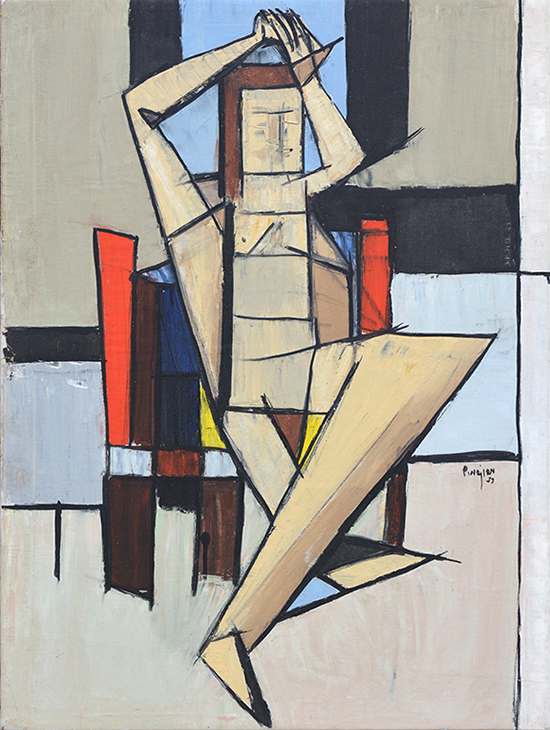
"No. 386" by Arthur Pinajian,1959.
.
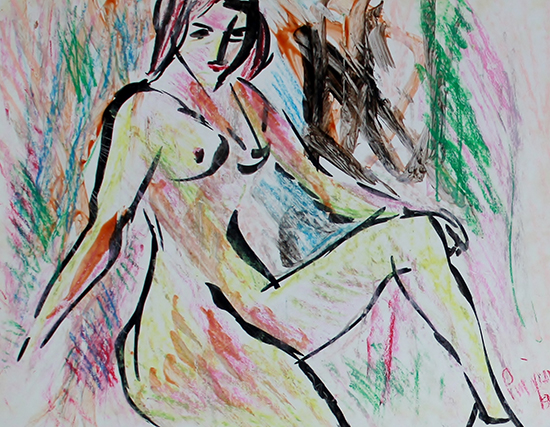
"No. 3913" by Arthur Pinajian, 1997.
.
Back from the war, Pinajian returned to the Art Students League on the G.I. bill and hoisted a few with Philip Guston and Franz Kline, joining in the fellowship of the Abstract Expressionists during that golden moment in art history. The heavyweight champion of the show in Quogue is a substantial oil on canvas from 1959: an angular seated nude with a harlequin-style background (blink and the figure seems clad in a harlequin costume, a la Picasso). Pinajian plays games with proportion by blowing up the crossed left leg to create a thrusting trapezoid that extends nearly half the picture.
This effect was one of the initial ideas for the painting, as shown in a little sketch that gallery director Chester Murray has juxtaposed with the painting, a curatorial invitation to visually ping pong between finished work and study. The blue and red grid in the background nods in homage to Mondrian, while the stiff posture reflects Pinajian’s fascination with his fellow Armenian, Arshile Gorky.
In his abundant writings, reflecting an artist who was both well-read and randy, Pinajian offers grammatically challenged gems on the studio process that mediate between life and life drawing, illuminating why that leg is so straight: “Drawing naturally is to tap knowledge one is not aware of … it’s the sensibilities we should strike at, not nature. The shape. The geometry.”
Pinajian spent more than two decades in Woodstock, New York, before moving to Bellport on Long Island with his sister late in life. A substantive series of Overlook Mountain, which became his Mt. St. Victoire, occupied him in 1959. The mountainscape in the show, No. 389, was painted two years later and yet is more coherently realistic than many of the earlier works, which I found intriguing as so often the motif veers toward abstraction instead of the other way around. With the vigorous black lines and choppy geology of a Marsden Hartley (especially in his Rockport quarry series) as well as some clouds out of Arthur Dow, this strong painting also owes some of its vocabulary to another American idiom.
.
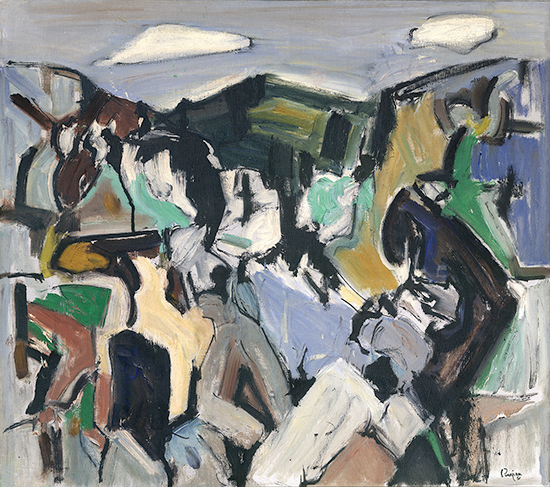
"No. 389" by Arthur Pinajian, 1961. Oil on canvas, 25 x 28 inches.
.
An exuberantly chromatic selection of large-scale works on bright white illustration board or paper (some watercolors, as well as acrylic) floods the bright and voluminous exhibition space. A few colorful highlights worth a closer look include the feather-light finger exercise No. 2526 (especially the racing matte black vertical strokes that alternate with bold orange bars) and the paler, lighter black strokes bookending No. 941, pure cursive plays on stage-like geometry backed by an abstract version of what could be a theater set by Raoul Dufy (including Dufy’s aqua as a border).
.

"No. 2526" by Arthur Pinajian.
.
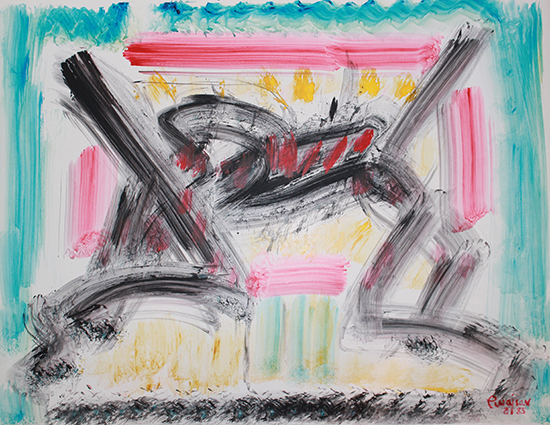
"No. 941" by Arthur Pinajian. Acrylic & Enamel on Illustration Board on Masonite, 21.25 x 27.5 inches.
.
I was also caught, in No. 2208, by the splatter of ink dots flung over a watercolor in what must have been a few minutes of pure ecstatic play. Kandinsky at his most improvisational is often close at hand when the Abstract Expressionists took watercolor and ink to white paper, no more clearly than in No. 1586, which experiments with color staining within the lozenge forms of 12 floating figures, like biomorphs seen under a microscope.
.

"No. 2208" by Arthur Pinajian. Ink and Water Color on Paper, 15 x 21 inches.
.
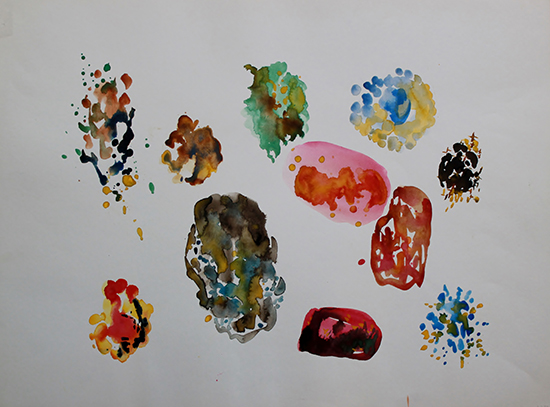
"No. 1586" by Arthur Pinajian. Water Color on paper, 18 x 29 inches.
.
A decade after the thrilling moment when Pinajian’s long-dormant cottage in Bellport was opened and thousands of works of art packed inside were brought to light, it is probably time to retire the “discovery” line. The more substantive hook for reflecting on stories of this kind is the intriguing probability of other artists from this epochal moment in American art history coming to light, and how their art historical fate might be served by the assiduous attention offered the Pinajian hoard by a determined team of heirs, dealers, collectors and art historians willing to stake their reputations on enthusiastic appraisal.
In the end the work has to speak for itself, as Pinajian’s does very clearly in this sampling of his art at the Quogue Gallery.
_______________________________
BASIC FACTS: “Arthur Pinajian: Works on Paper,” November 20 to December 31, 2015 at the Quogue Gallery, 44 Quogue Street, Quogue, NY 11959. www.Quoguegallery.com
_______________________________
Copyright 2015 Hamptons Art Hub LLC. All rights reserved.
